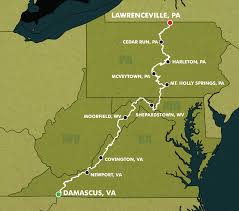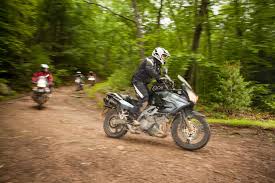I do some of my best thinking while riding, and on this trip I reflected quite a bit on adventure riding and the route we were taking, the pros and cons of group riding, and… tires!
The MABDR

The MABDR is a relatively non-technical adventure ride – a good way to introduce oneself to the sport. GPSKevin’s alternative sections allow you to bail out of gravel roads if you feel like it, or take some more challenging sections. The challenging sections were above my skill and guts level, featuring rutted and washed out dirt/’gravel roads, but they are there to try if you choose. We rode the MABDR in late summer when it was fairly dry so the water crossings (which I missed) were easy to navigate, and we found only superficial mud. Conditions in the spring when it is rainier would be quite different and more challenging.
The Appalachians are a beautiful part of the country and the MABDR provides direct access to the forests, mountains, valleys, and out-of-the-way places in the region. Although I didn’t see a lot of wildlife, I did see a lot of what looked like bear scat in the mountains, and a bobcat ran across the road only 20 yards in front of me one day in the foothills. The MABDR also provides easy access to the many historical sites along the way.
And, you don’t need to ride the entire route to enjoy it. The Pennsylvania sections of the MABDR are only a day’s ride from Cleveland and would make a nice extended weekend trip. Detail maps of the area show many similar roads to explore as well.
Adventure riding

I’ve always said, and I still do, that I like to ride gravel and dirt roads because they allow me to explore less traveled parts of the country, and the MABDR route did not disappoint in this regard. Some folks like to ride dirt, water crossings, steep hills, single tracks and trails, just for the fun of doing it, kind of like playing in the mud. I’m not one of them. I like rides like this one, or the Continental Divide Ride, or the legendary roads in Alaska and the north, because they take you to interesting, scenic places that you wouldn’t ordinarily get to in a car. So I’ll continue my adventure riding including, I hope, making to Tuktoyaktuk in the Northwest Territories in the summer of 2020.
Group riding

I generally prefer riding by myself. I like to ride my own pace on straightaways and curves, I like to stop when and where I want without having to check with anyone else, I like to sleep in and get a late start if I want, and I like to have time to keep my website up do date. When I’m by myself no one makes demands on my time, I don’t have to negotiate with anyone about stops, where and when to eat, or what route to take. Pretty self-centered, I know, but it is supremely enjoyable to ride alone.
Riding with another person can also be enjoyable if they have similar riding skills and interests, like to stop occasionally to take pictures and explore things, and are curious about where little side roads might lead even if they are not well maintained. A riding partner brings more ideas to the ride, can share the ups and downs of the ride with me, and can bail me out if I run out of gas or have a mechanical problem. And if I ride in remote areas a riding partner provides a measure of safety and protection should something happen to me.
Riding in a group as I did on this ride adds a social dimension you can’t get riding alone. We had fun planning the ride in the months before, learning about tracks and sharing GPS files, debating what tires to put on our bikes, all the time building excitement in anticipation of the ride. The ride itself was a shared adventure – how we rode, which roads we took, when and where ate, were all group decisions – enriched by the uniqueness of each of the guys on the ride. Riding as a group for seven days gave us a chance to know and appreciate each other in ways we hadn’t before. And we now have a collection of stories that we’ll be telling in the months to come, embellished more with each telling.